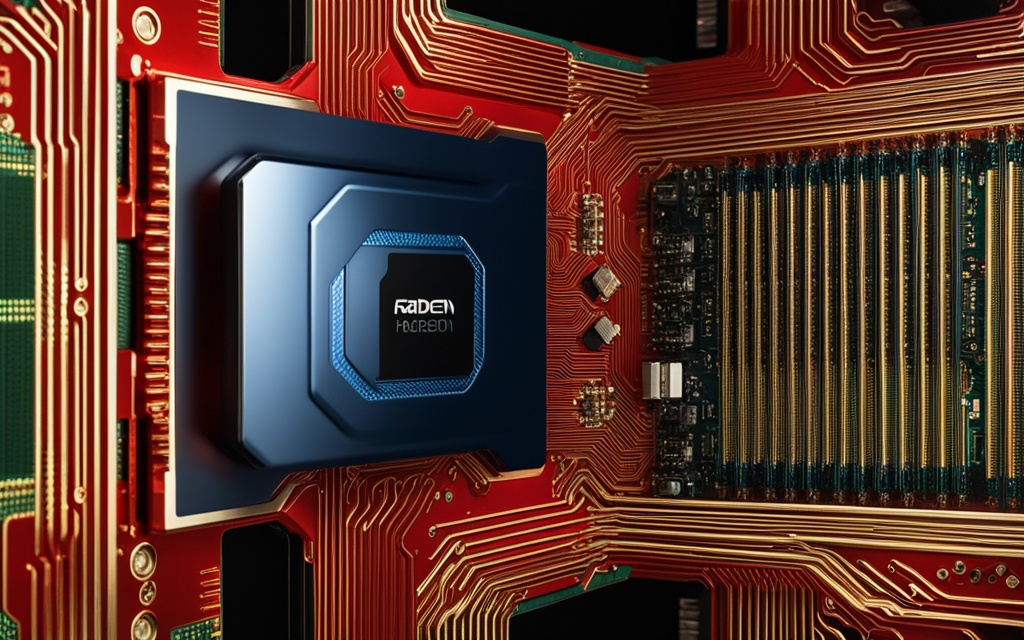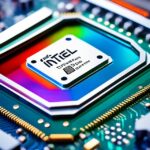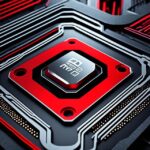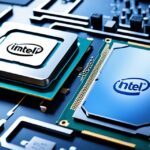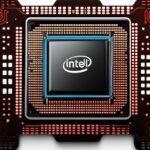Table of Contents
Combining Radeon GPUs with Intel CPUs is greatly interesting for those wanting top performance and flexibility. The evolution of technology brings up questions about AMD and Intel component fit, especially for gaming and heavy apps. Luckily, AMD GPUs mesh well with Intel CPUs, making sure they work together without problems1. This match-up offers a customisable way to build a powerful PC that does well in many areas.
Here, we’re going to look at the advantages of using Radeon GPUs with Intel CPUs. We’ll explore how this partnership is good for performance and can save money. But, we’ll also cover some issues you might run into, and how to fix them for the best PC use. For anyone wanting to push their gaming or general computing further, getting this pairing right matters. If you’re interested in making a VR-ready PC, check out this resource.
Key Takeaways
- Radeon GPUs and Intel CPUs provide seamless compatibility, promoting high performance in various applications.
- Users can enjoy flexible performance when pairing AMD GPUs with Intel CPUs, creating cost-effective build options.
- Driver compatibility and power considerations are crucial when combining theseComponents.
- Keeping drivers updated is essential for optimal performance between AMD GPUs and Intel CPUs.
- Understanding individual hardware specifications will ensure a smooth setup.
Understanding GPU and CPU Compatibility
In our high-tech world, having your GPU and CPU work well together is key. Exploring how GPUs fit with Intel CPUs can open up new possibilities. It’s possible to mix AMD’s Radeon GPUs with Intel CPUs, showing that brand loyalty doesn’t limit performance. This joining depends on various things like hardware specs, connections, and drivers. It’s crucial to match the right GPU with your CPU to make your tech run better.
General Compatibility Overview
Understanding what makes GPUs and CPUs work together is critical. They connect through the PCIe interface. This allows them to exchange data efficiently. There are several points to check for compatibility:
- Interface Compatibility: Check if the GPU and CPU use the same PCIe versions.
- Chipset Generation: Your chipset should handle your GPU’s needs.
- Driver Support: Keeping drivers updated ensures everything runs smoothly.
Pairing a medium-level CPU with a game-focused GPU often gives you great gaming quality2. Both parts need to be strong to avoid slowing down during use2. Knowing these aspects helps create a system that works well and uses its full potential.
Importance of Hardware Specs
Understanding hardware specs is crucial for blending hardware well. High-end GPUs offer advanced features like ray tracing which boost the visuals2. It’s recommended to choose GPUs with enough VRAM. 8GB might not be enough for tough programs3. Also, GPUs that can handle encoding can boost performance for streaming or intensive tasks2.
| Component | Importance |
|---|---|
| PCIe Interface | Ensures compatibility between GPU and CPU communication. |
| Chipset | Must support GPU functionalities for seamless integration. |
| Drivers | Updates are critical for optimal performance and feature support. |
| VRAM | More VRAM offers better performance in rendering and multitasking. |
Can I Use Radeon GPU With Intel CPU?
Yes, pairing a Radeon GPU with an Intel CPU is perfectly doable. Together, these components show AMD compatibility that’s top-notch. This mix lets you keep your system running smoothly, akin to NVIDIA GPUs with AMD setups1. So, you can boost both your graphics and processing power without worrying about performance drops.
Intel CPUs are great at tasks that need focus on one thing at a time. Radeon GPUs, on the other hand, are stars when it comes to creating images and managing many tasks at once. This balance gets the best out of both types of hardware. For those thinking about either upgrading or putting together a new system, this combination offers endless customisation options. You can confidently ask, “Can I use a Radeon GPU?” Yes, and expect stellar outcomes.
Moreover, with features like AMD’s Smart Access Memory (SAM), these setups get even better. SAM allows the CPU to use more of the GPU’s memory, easing bottlenecks and boosting performance, especially in gaming or graphic tasks4. This proves Radeon GPUs and Intel CPUs don’t just work together; they excel. It opens up a variety of options for your computing needs.
Benefits of Pairing Radeon GPUs with Intel CPUs
Combining Radeon GPUs with Intel CPUs offers a lot of advantages for both gamers and casual users. It’s not just about them working well together. It’s about creating a strong system that gives amazing gaming performance at a good price.
Flexible Performance for Gaming
Intel CPUs are known for their power, making them a great match with Radeon GPUs. This pairing lets gamers enjoy high frame rates and beautiful visuals. This greatly improves the gaming experience. Studies show that an Intel CPU with a Radeon GPU can keep up with more expensive options. This means gamers can enjoy smooth gameplay on many different games.
Cost-Effectiveness
Using Radeon GPUs with Intel CPUs is also cost-effective. This setup offers great gaming performance without the high price of similar setups. Radeon GPUs usually offer similar performance to their rivals but at a lower cost. This makes this combo a smart pick for gamers on a budget. For deeper insights into CPU and GPU performance, check out the Ultimate CPU Hierarchy Guide for 2023. It has detailed benchmarks to help users make smart choices for their gaming setups.
Challenges to Anticipate Using Radeon GPUs with Intel CPUs
Using Radeon GPUs with Intel CPUs can be thrilling. But, it comes with its own set of challenges. It is key to tackle compatibility challenges for a smooth link-up. This ensures the full power of both components is used.
Driver Compatibility Issues
Driver conflicts are a main problem. They can reduce your system’s performance. To prevent this, keep your drivers up to date. This constant upkeep is vital to avoid issues. Especially when changes in setups require new adjustments.
Checking for updates from Intel and AMD is crucial. It keeps your system running well. Ensuring a stable and efficient performance is important for a good experience.
Power Consumption Considerations
Power use is also vital to consider. Mixing Radeon GPUs with Intel CPUs could need more power. This means looking at how your system cools is important.
Keeping things running cool is necessary for top performance. Both components add to your setup’s total power use. So, taking care of thermal management is key.
Knowing these points helps tackle any compatibility challenges. This leads to a strong link between Radeon and Intel tech. Find out more about the growth of CPU and GPU tech in this deep dive5
Setting Up Your System with Radeon GPUs and Intel CPUs
Setting up a system with Radeon GPUs and Intel CPUs needs careful attention. First, check that all parts work well together. This step is crucial for the best performance of your system.
Verifying Hardware Compatibility
It’s important to check if your hardware matches well before setting up. Many motherboards today can fit different parts, offering flexibility6. Always look online or check with the maker to be sure about compatibility. Many beginners prefer Intel CPUs with AMD GPUs for their good performance and fit6.
Installing Necessary Drivers
After making sure your hardware is compatible, it’s time to install drivers. Downloading the latest drivers is key. Old software can cause problems between the GPU and CPU7. Also, turning on Resizable BAR (ReBAR) improves gaming performance by letting the CPU use more GPU memory4. Keeping technology up-to-date makes your computer run better.
Conclusion
Mixing Radeon GPUs with Intel CPUs opens up brilliant prospects for improved compatibility and performance. Modern motherboards are built to accommodate various components easily. This makes combining these technologies straightforward6. Intel CPUs excel in single-core tasks, while Radeon GPUs by AMD offer top-notch graphics. Together, they offer a potent mix for gaming and creative work8.
However, there are challenges like driver compatibility to keep in mind. Knowing about these issues helps make building or upgrading systems smoother. It allows users to make the most of their equipment6.
This partnership offers exciting opportunities for both tech enthusiasts and everyday users. It prompts them to consider Radeon GPUs and Intel CPUs for their next setup. With careful planning, they can assemble a powerful and cost-effective computer8.
FAQ
Can I use a Radeon GPU with an Intel CPU?
Yes, you can. Radeon GPUs work well with Intel CPUs. They offer a smooth and efficient computing experience without any big problems.
What do I need to consider for GPU and CPU compatibility?
You should check the hardware specs. Make sure the PCIe interface and chipset generation match. Also, having the right drivers is key for good communication between your Radeon GPU and Intel CPU.
Are there performance benefits to using Radeon GPUs with Intel CPUs?
Definitely. Intel CPUs are known for their strong performance. This makes them great partners for Radeon GPUs. They are especially good for gaming, where you want high frame rates and sharp images.
What challenges might I face when using Radeon GPUs with Intel CPUs?
You might run into driver compatibility problems. Power use and heat need careful management too. It’s important to keep your drivers updated and have good cooling in your system.
How can I set up a system with Radeon GPUs and Intel CPUs?
First, check that your hardware works together. Then, download the latest drivers from trusted sources. This makes sure your GPU and CPU can talk to each other well.
Is pairing Radeon GPUs with Intel CPUs cost-effective?
Yes, it’s a good money choice. Radeon graphics cards offer great performance at a good price. This means gamers can get top-notch gaming without breaking the bank.
Source Links
- https://techyimpacts.com/does-amd-gpu-work-with-intel-cpu/ – Does AMD GPU Work With Intel CPU – Explore Compatibility!
- https://www.cherryservers.com/blog/gpu-vs-cpu-for-gaming – GPU vs CPU for Gaming | Cherry Servers
- https://forum.blackmagicdesign.com/viewtopic.php?f=21&t=184881 – Blackmagic Forum • View topic
- https://www.digitaltrends.com/computing/can-use-intel-arc-with-amd-ryzen/ – Can I use an Intel Arc GPU with AMD Ryzen? | Digital Trends
- https://www.youngwonks.com/blog/amd-vs-intel – Which is better AMD or Intel? Which is better Intel Core i7 or AMD Ryzen 7? Which is better Ryzen or Intel for programming?
- https://medium.com/@mziauldin2/why-pairing-an-amd-gpu-with-an-intel-cpu-is-a-smart-choice-for-beginners-07ff45d7e362 – Why Pairing an AMD GPU with an Intel CPU is a Smart Choice for Beginners
- https://www.cgdirector.com/use-amd-gpu-with-intel-cpu/ – Can You Use An AMD GPU With An Intel CPU?
- https://stackoverflow.com/questions/37980591/how-can-intel-and-amd-be-different-but-still-compatible – How can Intel and AMD be different but still compatible?

